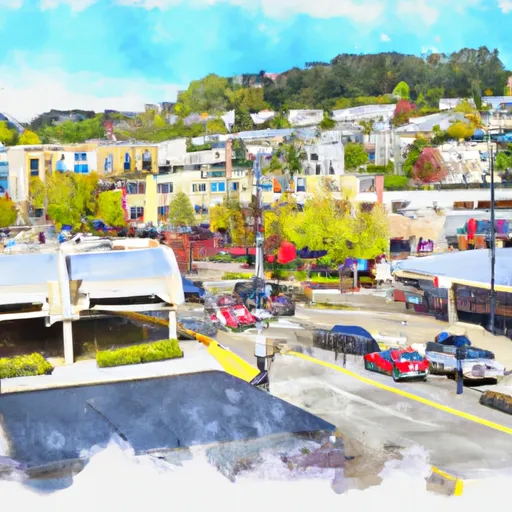-
 Snoflo Premium
Snoflo Premium
Get unlimited access to all our content
With no Ad interruptions! - Start Your Free Trial Login with existing account
Bremerton
Eden Index
Climate
8.1
•
Recreation
3.7
•
Community
2.8
•
Safeguard
5.2/10

Bremerton is a city in Kitsap County, Washington, located on the Kitsap Peninsula. The city has a marine west coast climate with mild and wet winters and cool summers. The annual precipitation is around 55 inches, with most of it falling between October and April. The hydrology constituents of the area include the Puget Sound and several tributaries, including the Sinclair Inlet and Ostrich Bay.
Outdoor recreation opportunities in Bremerton include hiking, biking, kayaking, and fishing. The city is surrounded by several state parks, including Illahee State Park and Manchester State Park. Other popular outdoor destinations include Gold Mountain Golf Course and the Olympic Mountains, which are just a short drive away. The city also has several marinas and waterfront parks, including the Harborside Fountain Park and the Bremerton Boardwalk, which offer stunning views of the Puget Sound.
What is the Eden Index?
The Snoflo Eden Index serves as a comprehensive rating system for regions, evaluating their desirability through a holistic assessment of climate health, outdoor recreation opportunities, and natural disaster risk, acknowledging the profound impact of these factors on livability and well-being.
Climate Health Indicator (CHI): 8.1
Bremerton receives approximately
1216mm of rain per year,
with humidity levels near 82%
and air temperatures averaging around
11°C.
Bremerton has a plant hardyness factor of
8, meaning
plants and agriculture in this region tend to thrive here all year round.
By considering the ideal temperature range, reliable water supplies, clean air, and stable seasonal rain or snowpacks, the Climate Health Indicator (CHI) underscores the significance of a healthy climate as the foundation for quality living.
A healthy climate is paramount for ensuring a high quality of life and livability in a region, fostering both physical well-being and environmental harmony. This can be characterized by ideal temperatures, reliable access to water supplies, clean air, and consistent seasonal rain or snowpacks.
Weather Forecast
Streamflow Conditions
Puget Sound
Area Rivers
Puget Sound
Snowpack Depths
Puget Sound
Reservoir Storage Capacity
Puget Sound
Groundwater Levels
Recreational Opportunity Index (ROI): 3.7
The Recreational Opportunity Index (ROI) recognizes the value of outdoor recreational options, such as parks, hiking trails, camping sites, and fishing spots, while acknowledging that climate plays a pivotal role in ensuring the comfort and consistency of these experiences.
Access to outdoor recreational opportunities, encompassing activities such as parks, hiking, camping, and fishing, is crucial for overall well-being, and the climate plays a pivotal role in enabling and enhancing these experiences, ensuring that individuals can engage in nature-based activities comfortably and consistently.
Camping Areas
| Campground | Campsites | Reservations | Toilets | Showers | Elevation |
|---|---|---|---|---|---|
| Penrose Point State Park | 82 | 15 ft | |||
| Fay Bainbridge State Park | 65 | 15 ft | |||
| Manchester State Park | 35 | 27 ft | |||
| Illahee State Park | 23 | 254 ft | |||
| Kopachuck State Park | 21 | 234 ft | |||
| Joemma Beach State Park | 19 | 86 ft | |||
| Kitsap Memorial State Park | 40 | 46 ft |
Nearby Ski Areas
Catastrophe Safeguard Index (CSI):
The Catastrophe Safeguard Index (CSI) recognizes that natural disaster risk, encompassing floods, fires, hurricanes, and tornadoes, can drastically affect safety and the overall appeal of an area.
The level of natural disaster risk in a region significantly affects safety and the overall livability, with climate change amplifying these risks by potentially increasing the frequency and intensity of events like floods, fires, hurricanes, and tornadoes, thereby posing substantial challenges to community resilience and well-being.
Community Resilience Indicator (CRI): 2.8
The Community Resilience Indicator (CRI) recognizes that education, healthcare, and socioeconomics are crucial to the well-being of a region. The CRI acknowledges the profound impact of these elements on residents' overall quality of life. By evaluating educational resources, healthcare accessibility, and economic inclusivity, the index captures the essential aspects that contribute to a thriving community, fostering resident satisfaction, equity, and social cohesion.

